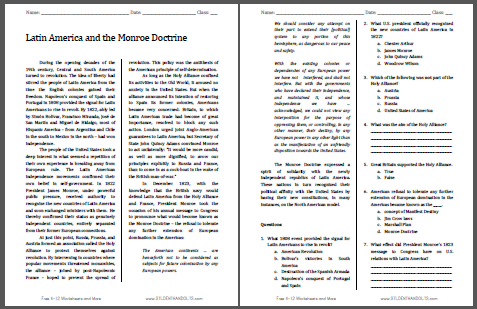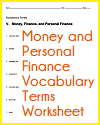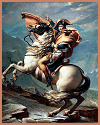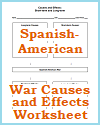| Latin America and the Monroe Doctrine Reading with Questions |
|---|
| www.studenthandouts.com ↣ American History ↣ American History Readings with Questions |
During the opening decades of the 19th century, Central and South America turned to revolution. The idea of liberty had stirred the people of Latin America from the time the English colonies gained their freedom. Napoleon's conquest of Spain and Portugal in 1808 provided the signal for Latin Americans to rise in revolt. By 1822, ably led by Simón Bolívar, Francisco Miranda, José de San Martín and Miguel de Hidalgo, most of Hispanic America—from Argentina and Chile in the south to Mexico in the north—had won independence. The people of the United States took a deep interest in what seemed a repetition of their own experience in breaking away from European rule. The Latin American independence movements confirmed their own belief in self-government. In 1822 President James Monroe, under powerful public pressure, received authority to recognize the new countries of Latin America and soon exchanged ministers with them. He thereby confirmed their status as genuinely independent countries, entirely separated from their former European connections.
The people of the United States took a deep interest in what seemed a repetition of their own experience in breaking away from European rule. The Latin American independence movements confirmed their own belief in self-government. In 1822 President James Monroe, under powerful public pressure, received authority to recognize the new countries of Latin America and soon exchanged ministers with them. He thereby confirmed their status as genuinely independent countries, entirely separated from their former European connections.At just this point, Russia, Prussia, and Austria formed an association called the Holy Alliance to protect themselves against revolution. By intervening in countries where popular movements threatened monarchies, the alliance—joined by post-Napoleonic France—hoped to prevent the spread of revolution. This policy was the antithesis of the American principle of self-determination... Questions with answers in bold: 1. What 1808 event provided the signal for Latin Americans to rise in revolt? a. American Revolution b. Bolivar's victories in South America c. Destruction of the Spanish Armada d. Napoleon's conquest of Portugal and Spain 2. What U.S. president officially recognized the new countries of Latin America in 1822? a. Chester Arthur b. James Monroe c. John Quincy Adams d. Woodrow Wilson 3. Which of the following was not part of the Holy Alliance? a. Austria b. Prussia c. Russia d. United States of America 4. What was the aim of the Holy Alliance? By intervening in countries where popular movements threatened monarchies, the alliance hoped to prevent the spread of revolution. 5. Great Britain supported the Holy Alliance. a. True b. False 6. American refusal to tolerate any further extension of European domination in the Americas became known as the _____. a. concept of Manifest Destiny b. Jim Crow laws c. Marshall Plan d. Monroe Doctrine 7. What effect did President Monroe's 1823 message to Congress have on U.S. relations with Latin America? It expressed a spirit of solidarity with the newly independent republics of Latin America. These nations in turn recognized their political affinity with the United States by basing their new constitutions, in many instances, on the North American model. Click here to print. |
 |  |  |  |  |  |
| www.studenthandouts.com ↣ American History ↣ American History Readings with Questions |








